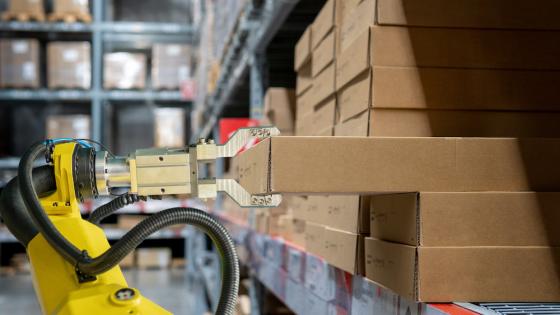Over the last decade, automation has increasingly been adopted as a full substitution of capital for labour—as opposed to a standard form of labour-augmenting technological change. Figure 1 illustrates this trend, charting the stock of operative industrial robots worldwide over time, based on International Federation of Robotics data (IFR 2016, 2017, 2018, 2019). The number of industrial robots increased by factor of three over the course of a decade, rising from a little over one million operative units in 2010 to a projected 3.15 million units in 2020. Over the same time, robots reportedly became capable of substituting for, or even outperforming, humans for many tasks, such as producing customised parts and medical implants using 3D printing technologies, diagnosing diseases, and assisting decision making, for example, by ‘robot judges’ (Ford 2015, Baldwin 2019, Re and Solow-Niederman 2019). In a just-released book (Prettner and Bloom 2020), we explore theory, evidence, and policy related to the economic and social consequences of the world’s increasing reliance on robots, automated processes, and artificial intelligence.
Figure 1 Worldwide stock of operative industrial robots (in millions)
Notes: Worldwide stock of operative industrial robots in millions of units over time, according to IFR (2016, 2017, 2018, 2019), with our own interpolations for the years lacking data. The solid line refers to actual data and interpolations up to 2018, and the dotted line refers to IFR (2019) forecasts until 2022.
While automation can (and did) improve productivity, per capita output, and living standards in general (see, for example, Brynjolfsson and McAfee 2014, Acemoglu and Restrepo 2018, Graetz and Michaels 2018), two crucial aspects of automation raise concerns: its disproportionate impact on low-skill workers and its overall negative impact with respect to the share of income that goes to labour as opposed to capital. Both of these impacts tend to exacerbate income inequality.
Routine and low-skill tasks continue to be easier for robots to perform than non-routine, high-skill tasks (Arntz et al. 2017, Frey and Osborne 2017, Dauth et al. 2017, Acemoglu and Restrepo 2020). This implies that increases in the number of robots or improvements in their productivity tend to affect low-skilled workers much more adversely than high-skilled workers. Moreover, high-skilled workers tend to specialise in tasks to which automation is complementary, such as robot design and maintenance, supervision, and management. The differential impact of automation implies that the wages of low-skilled workers might stagnate and even decline in the presence of automation (Lankisch et al. 2019). This result is consistent with the data in Figure 2, which shows the real income of persons with a high school degree in the US from 1991 to 2018, according to the US Census Bureau (2020). Simultaneously, high-skilled workers’ wages may rise as a result of automation, potentially increasing wage and income inequality (Piketty 2014, Prettner and Bloom 2020).
Figure 2 Median real income of persons with a high school degree (in USD)
Notes: Median real income in US$ (base year 2018) of persons with a high school degree from 1991 to 2018 in the United States, according to the United States Census Bureau (2020).
When robots constitute a perfect substitute for labour, workers and robots compete directly on the labour market, holding human wages down. The ‘wages’ that robots earn flow to their owners and are therefore capital income. As a consequence, automation leads to a declining labour income share (Prettner 2019, Prettner and Strulik 2020). Because labour income is more equally distributed than capital ownership and capital income are, this leads—mechanically—to a further increase in overall income inequality (see Piketty 2014, Piketty and Zucman 2014). This line of argument is consistent with the trend in the labour income share shown in Figure 3. The labour income share decreased from about 65% in 1970 to below 60% in 2017 (Federal Reserve Bank 2020); at the same time, the number of robots was rising. Of course automation is not the only factor that influences the labour income share, but calibrations suggest that automation could account for an approximate one percentage point decline in the labour income share since the 1970s (Prettner 2019).
Figure 3 Share of labour compensation in GDP in the US
Notes: Share of labour compensation in GDP in the US over time, according to Federal Reserve Bank (2020) data.
To summarise, theoretical arguments and empirical results predating the emergence of COVID-19 indicate that automation has led (and will continue to lead) to (i) increasing productivity and average incomes, (ii) negative employment and wage effects for low-skilled workers, but either insignificant or positive employment and wage effects for high-skilled workers, and (iii) a decline in the labour income share (see also Prettner and Bloom 2020).
Potential policy measures to mitigate the negative consequences of automation include (i) educational investments—particularly in talented individuals from low-income households—such as stipends, tuition-fee waivers, and student housing, (ii) retraining programs for displaced workers, (iii) reforming school curricula to focus more on skills that are complementary to automation technologies and less on memorising facts, (iv) strengthening elements of the social security system that support those who are displaced by robots, such as health insurance coverage for those who are not employed, and (v) reducing taxes on labour and instead increasing taxes on polluting activities or, for example, on undeveloped land.
COVID-19 and automation
The COVID-19 pandemic and the assured occurrence of future pandemics foster the adoption of automation technologies and reinforce the previously described patterns. Several factors explain this relationship.
First, automation, robotics, modern information and communication technologies, and artificial intelligence have been incredibly useful in fighting the pandemic, as well as in alleviating its economic consequences. These technologies have allowed firms to continue to operate by facilitating social distancing in the workplace and by enabling remote work from home offices. In general, because better-educated workers with higher incomes can take advantage of these opportunities and many less-educated, lower-income workers cannot, automation and related technologies have translated the COVID-19 shock into greater social and economic inequality, even as they reduce the pandemic’s overall economic impact. The disproportionate impact of COVID-19 on disadvantaged ethnic minorities and lower-income individuals—who have poor access to health care and often face higher infection risk due to reliance on public transportation and lack of opportunities to socially distance in the workplace—further magnifies this trend.
Second, the COVID-19 pandemic will likely accelerate the development and implementation of automation technologies because of greater incentives to substitute capital for labour. The reason is that the former is obviously not susceptible to pathogens that affect humans (although they might be quite susceptible to digital pathogens). In addition, working from home might become much more widespread, now that it has been tested on a large scale, acting against the corresponding status quo bias against remote working of firms and bureaucracies.
Third, robots and smart technologies offer great potential for disease surveillance and contact tracing, diagnosing COVID-19 and other diseases without face-to-face contact, and even disinfecting contaminated areas in hospitals and other public spaces (Blake 2020). Consequently, they may help policymakers limit the progression of COVID-19 without (or with only minimal and targeted) lockdown measures.
Fourth, supply chain and travel disruptions caused by COVID-19 might undermine the integration of economies and encourage self-reliant economic systems, at least in (strategically) important sectors such as the production of medical supplies and drugs, or the production of necessary inputs for assembling sophisticated machines, cars, and planes—the final production of which usually still occurs in high-wage countries. While policymakers might hope that the corresponding re-shoring of supply chains could help create jobs for low-skilled workers and thereby raise their wages, theoretical arguments and empirical evidence on re-shoring and automation show that this would instead enhance robot adoption and not improve the lot of low-skilled workers (Krenz et al. 2020).
Conclusion
While automation is likely to foster overall economic prosperity, it comes at the price of increasing inequality. The COVID-19 pandemic is reinforcing both the trend towards automation and its effects. The main challenge here is to ensure that as many as possible will benefit from the positive economic and social effects of automation to prevent a situation in which a substantial part of society is disconnected from the gains brought by technological progress.
References
Acemoglu, D and P Restrepo (2018), “The race between man and machine: implications of technology for growth, factor shares, and employment”, American Economic Review 108 (6): 1488–1542.
Acemoglu, D and P Restrepo (2020), “Robots and jobs: evidence from US labor markets”, Journal of Political Economy (forthcoming).
Arntz, M, T Gregory and U Zierahn (2017), “Revisiting the risk of automation”, Economics Letters 159 (C): 157–160.
Baldwin, R (2019), The Globotics Upheaval: Globalization, Robotics, and the Future of Work, Oxford: Oxford University Press.
Blake, R (2020), “In coronavirus fight, robots report for disinfection duty”, Forbes, 17 April.
Brynjolfsson, E and A McAfee (2014), The second machine age: work, progress, and prosperity in a time of brilliant technologies, New York: Norton & Company.
Dauth, W, S Findeisen, J Suedekum and N Woessner (2017), “German robots—the impact of industrial robots on workers”, CEPR Discussion Paper 12306.
Ford, M (2015), Rise of the robots: technology and the threat of a jobless future, New York: Basic Books.
Federal Reserve Bank (2020), “Share of labour compensation in GDP at current national prices for United States”, Accessed on 6 June 2020.
Frey, C B and M A Osborne (2017), “The future of employment: how susceptible are jobs to computerisation?”, Technological Forecasting and Social Change 114 (C): 254–280.
Graetz, G and G Michaels (2018), “Robots at work”, The Review of Economics and Statistics 100 (5): 753–768.
IFR (International Federation of Robotics) (2016), “Executive summary world robotics 2016 industrial robots”, Accessed on 1 August 2018.
IFR (International Federation of Robotics) (2017), “Executive summary world robotics 2017 industrial robots”, Accessed on 1 August 2018.
IFR (International Federation of Robotics) (2018), “Executive summary world robotics 2018 industrial robots”, Accessed on 10 February 2019.
IFR (International Federation of Robotics) (2019), “Press conference 18th September 2019”, Accessed on 6 June 2020.
Krenz, A, K Prettner and H Strulik (2020), “Robots, reshoring, and the lot of low-skilled workers”, GLO Discussion Paper Series 443, Global Labor Organization (GLO), Essen, Germany.
Lankisch, C, K Prettner and A Prskawetz (2019), “How can robots affect wage inequality?”, Economic Modelling 81 (C): 161–169.
Piketty, T (2014), Capital in the twenty-first century, Cambridge, MA: The Belknap Press of Harvard University Press.
Piketty, T and G Zucman (2014), “Capital is back: wealth-income ratios in rich countries 1700–2010”, The Quarterly Journal of Economics 129 (3): 1255–1310.
Prettner, K (2019), “A note on the implications of automation for economic growth and the labor share”, Macroeconomic Dynamics 23 (3): 1294–1301.
Prettner, K and D E Bloom (2020), Automation and its macroeconomic consequences. Theory, evidence, and social impacts, Cambridge, MA: Academic Press.
Prettner, K and H Strulik (2020), “Innovation, automation, and inequality: policy challenges in the race against the machine”, Journal of Monetary Economics (forthcoming).
Re, R M and A Solow-Niederman (2019), “Developing Artificially Intelligent Justice”, Stanford Technology Law Review 22: 242–289.
United States Census Bureau (2020), “Historical income tables”, Accessed on 10 June 2020.




